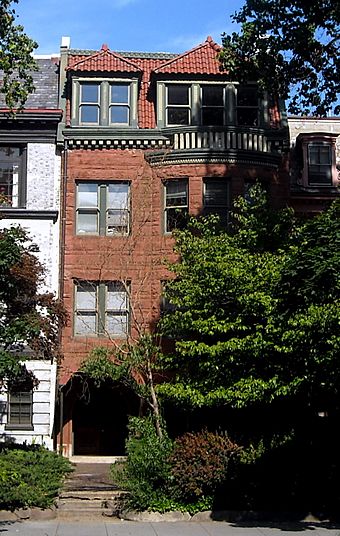Robert Simpson Woodward House facts for kids
|
Robert Simpson Woodward House
|
|
 |
|
| Location | 1513 16th Street, NW Washington, D.C. |
|---|---|
| Built | 1895 |
| Architect | William M. Conley |
| Architectural style | Richardsonian Romanesque |
| NRHP reference No. | 76002136 |
Quick facts for kids Significant dates |
|
| Added to NRHP | January 7, 1976 |
| Designated NHL | January 7, 1976 |
The Robert Simpson Woodward House is an old home in Washington, D.C.. It is located at 1513 16th Street, in the Dupont Circle area. From 1904 to 1914, this house was the home of geologist Robert Simpson Woodward. He was a very important scientist and the first president of the Carnegie Institution for Science.
Today, the building is the main office for the Capital Research Center. In 1976, it was named a National Historic Landmark. This means it is a very special place in American history. It also became part of the Sixteenth Street Historic District in 1978.
Contents
What Does the Woodward House Look Like?
The Robert Simpson Woodward House is found just north of Scott Circle. It is on the east side of 16th Street NW. This building is four stories tall and made of brick. It has a style called Romanesque.
Some cool parts of the house include its unique roof windows. These windows are called hipped dormers and have tile roofs. The main entrance is set back under a round arch. There is also a curved window section on the right side. This window section goes all the way up to the third floor.
Who Built the Woodward House?
The house was built in 1895. It was designed by an architect named William M. Conley. Robert Simpson Woodward lived here for ten years, from 1904 to 1914. This was one of the longest times he lived in one place.
Who Was Robert Simpson Woodward?
Robert Simpson Woodward was born in Michigan. He studied civil engineering at the University of Michigan. After college, he started working for the United States Geological Survey.
What Did Woodward Study?
Woodward had a long and amazing career. He made big contributions to many different fields. These included astronomy, mathematics, surveying, and geology. He was also known for being a great leader. Before joining the Carnegie Institution, he was a dean at Columbia University. In 1903, he became the very first head of the Carnegie Institution.



